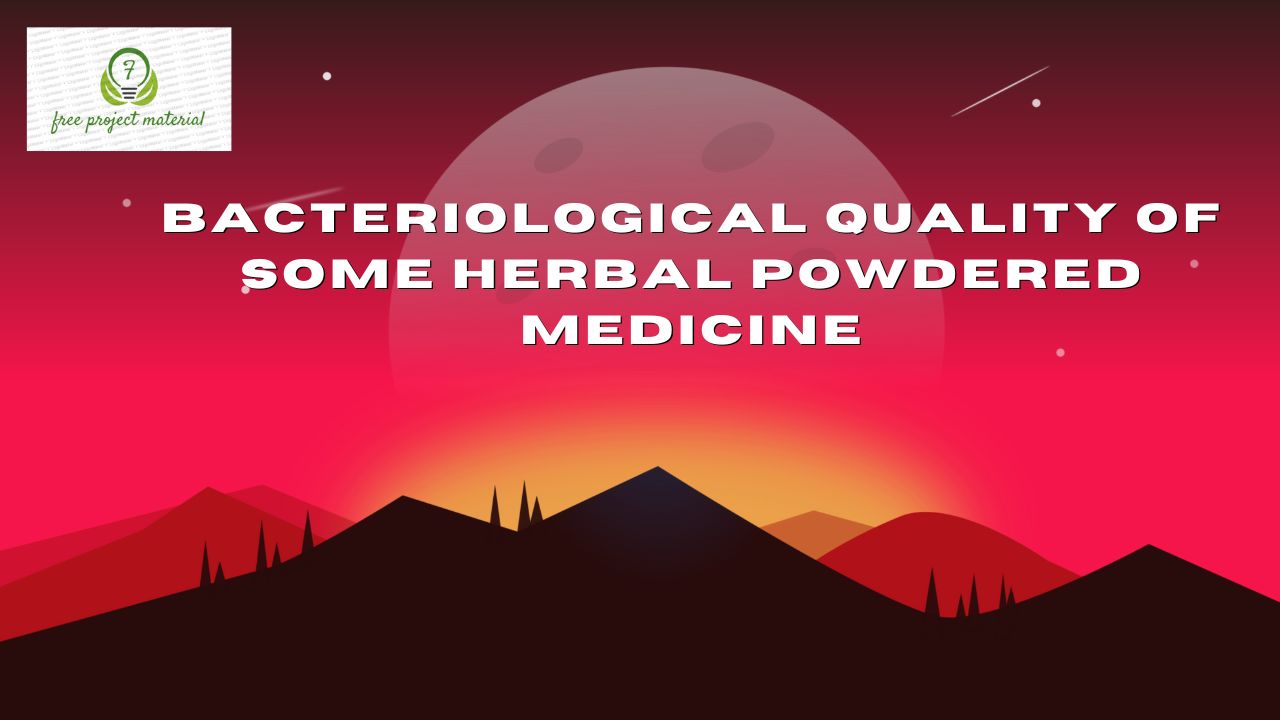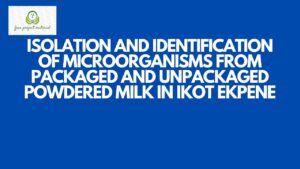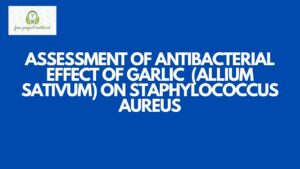ABSTRACT
The bacteriological quality of some powdered herbal medicine sold at Otor Market in Ikot Ekpene metropolis was determined using standard bacteriological methods. The result of the study revealed that sample A had the highest heterotrophic bacterial count of 2.64×107 cfu/g, followed by sample B (2.34×107 cfu/g) while sample C had the least with 9.0×106 cfu/g. The cultural, microscopical and biochemical characterization of the bacterial isolates revealed the presence of the following bacterial isolates; Pseudomonas sp, Escherichia sp., Salmonella sp and Staphylococcus sp. Percentage frequency occurrence of the isolates revealed that Staphylococcus sp had the highest percentage occurrence of 30.8% while Salmonella sp had the least with 20.6%. The level of bacterial contamination was above the WHO permissible limit of <105 cfu/g which is an implication for foodborne disease outbreak.
TABLE OF CONTENTS
Tithe page – – – – – – – – – i
Certification – – – – – – – – – ii
Dedication – – – – – – – – – iii
Acknowledgements – – – – – – – iv
Abstract – – – – – – – – – v
Table of contents – – – – – – – – vi-viii
CHAPTER ONE
INTRODUCTION – – – – – – – 1-2
1.1 Aim of the Study – – – – – – – 2
1.2 Objectives of the Study – – – – – – 2
1.3 Scope and Limitation of the Study – – – – 3
CHAPTER TWO
2.0 LITERATURE REVIEW
2.1 Herbal Drugs – – – – – – – – 4-5
2.2 Biological Component of Herbal Drugs – – – – 5-8
2.3 Uses of Herbal Drugs – – – – – – 9-11
2.4 Differences Between Herbal Drugs and Conventional Drugs – 11-23
2.5 Herbal Drugs Spoilage – – – – – – 13-15
2.6 Types of Herbal Drugs Spoilage – – – – – 15
2.6.1 Non-microbial Herbal Drugs Spoilage – – – 15
2.6.2 Microbial Spoilage – – – – – – 16-19
2.6.3 Enzymatic Spoilage – – – – – – 19
2.7 Causes of Herbal Drugs – – – – – – 20-23
2.8 Factors Affecting Quality of Herbal Drugs – – – 23
2.8.1 Intrinsic Factors – – – – – – – 23-25
2.8.2 Extrinsic Factors – – – – – – – 25-26
2.9 Herbal Drugs Contamination and Illness – – – 26
2.9.1 Herbal Drug Contamination – – – – – 26-28
2.9.2 Herbal Drug Illness – – – – – – 28
2.10 Diseases in Herbal Drug – – – – – – 29
2.11Presentation of Herbal Drugs – – – – – 29-33
CHAPTER THREE
3.0 MATERIALS AND METHOD
3.1 Sample Collection – – – – – – – 34
3.2 Sterilization of Glasswares and Media – – – – 34-35
3.3 Bacteriological Analysis of Samples – – – – 35
3.3.1 Serial Dilution – – – – – – – 35
3.3.2 Inoculation – – – – – – – 35-36
3.3.3 Enumeration – – – – – – – 36
3.3.4 Purification and Stocking of Isolates – – – – 36
3.3.5 Identification and Characterization of Isolates – – 37
CHAPTER FOUR
4.0 RESULTS AND DISCUSSION
4.1 Results – – – – – – – – 38-40
4.2 Discussion – – – – – – – 41-43
CHAPTER FIVE
5.0 CONCLUSION AND RECOMMENDATIONS
5.1 Conclusion – – – – – – – – 44
5.2 Recommendations – – – – – – – 44-45
REFERENCES
APPENDIX
CHAPTER ONE
1.0 INTRODUCTION
The use of herbs as medicine is the oldest form of healthcare known to humanity and has been in all cultures throughout history (Barnes et al., 2007). Early humans recognized their dependence on nature for a healthy life and since that time humanity is depending on the diversity of plant resources for food, clothing, shelter and medicine to cure myriads of ailments. Led by instinct, taste, and experiences, primitive Men and Women treated illness by using plants, animal plants and minerals that were not part of their usual diet. Primitive people learned by trial and error to distinguish useful plants with beneficial effects from those that were toxic or inactive and also which combinations or processing methods had to be used to gain consistent and optimal results.
Even in ancient cultures, tribal people methodically collected information on herbs and developed well-defined herbal remedies some sixty thousand years ago has been found in a burial site of a Neanderthal man uncovered in 1960 in a cave in northern Iraq (Solecki, 1975).
Indeed, well into the twentieth century, much of the pharmacopeia of scientific medicine was derived from the herbal lore of native people .the knowledge of plant-based drugs developed gradually and was passed on, thus, laying the foundation for many systems of traditional medicine all over the world. In some communities herbal medicine is still a central part of their medical system.
1.1 Aim of The Study
The aim of this study is to determine the bacteriological quality of some powdered herbal medicine sold at Otor Market in Ikot Ekpene metropolis.
1.2 Objectives of the Study
(i) To determine the bacteriological quality of some herbal medicine
(ii) To isolate and identity bacteria present in some herbal medicine
(iii) To give recommendations based on the findings.
1.3 Scope and Limitation of the Study
The scope of this research work is to determine the bacteriological quality of some powdered herbal medicine in Ikot Ekpene metropolis and the factor limiting this work was time, financial constraints and lack of adequate facility and good working environment.



